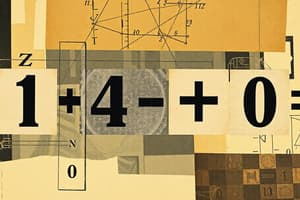Podcast
Questions and Answers
Addition allows us to combine numbers to create new ________.
Addition allows us to combine numbers to create new ________.
values
Mathematically, addition is represented by the symbol ______.
Mathematically, addition is represented by the symbol ______.
To solve an addition problem, start from the ________ digit.
To solve an addition problem, start from the ________ digit.
rightmost
The ______ property states that the order of numbers being added does not affect the sum.
The ______ property states that the order of numbers being added does not affect the sum.
The ______ property states that the grouping of numbers being added does not affect the sum.
The ______ property states that the grouping of numbers being added does not affect the sum.
The Identity Property of Zero states that adding zero to any number results in the ______ number.
The Identity Property of Zero states that adding zero to any number results in the ______ number.
Adding the additive inverse of a number results in ______
Adding the additive inverse of a number results in ______
The sum of two negative numbers is ______
The sum of two negative numbers is ______
Addition helps us calculate the total cost of ______
Addition helps us calculate the total cost of ______
Addition is essential in measuring ______, volumes, and weights
Addition is essential in measuring ______, volumes, and weights
Addition aids in ______, such as finding sums of consecutive numbers
Addition aids in ______, such as finding sums of consecutive numbers
Visualizing addition on a number line helps us understand the properties of addition more ______
Visualizing addition on a number line helps us understand the properties of addition more ______
Flashcards are hidden until you start studying
Study Notes
Arithmetic Operations: Exploring Addition
Arithmetic operations form the foundation of mathematical reasoning, and one of the most fundamental of these operations is addition. Addition allows us to combine numbers to create new values. With a clear understanding of addition, we can build a strong foundation for more complex mathematical concepts.
The Basics of Addition
Addition is the process of joining two or more quantities to find their total. Mathematically, it is represented by the symbol "+" and follows the set of rules and properties that govern addition.
For example, let's consider adding the numbers 3 and 4. To solve this addition problem, we would write it as 3 + 4, and then follow these steps:
- Align the digits of the numbers in a column.
- Start from the rightmost digit, adding and carrying if necessary.
- Write the result below the addition bar.
In this case, the addition would look like this:
3 + 4
---
7
The Common Properties of Addition
Addition follows certain properties that allow us to solve problems in a variety of ways. Here are some of the key properties of addition:
- Commutative Property: The order of the numbers being added does not affect the sum. For example, 3 + 4 = 4 + 3.
- Associative Property: The grouping of numbers being added does not affect the sum. For example, (3 + 4) + 5 = 3 + (4 + 5).
- Identity Property of Zero: Adding zero to any number results in the same number. For example, 3 + 0 = 0 + 3 = 3.
- Property of Zero Property of Negatives: Adding the additive inverse of a number results in zero. For example, 3 + (-3) = 0 + 3 = 3.
- Property of Addition of Negatives: The sum of two negative numbers is negative. For example, (-3) + (-2) = -5.
Applications of Addition
Addition contributes to many aspects of everyday life and mathematical exploration. Here are a few examples of its applications:
- Addition helps us calculate the total cost of purchases.
- Addition is essential in measuring distances, volumes, and weights.
- Addition plays a crucial role in data analysis and statistics.
- Addition aids in counting, such as finding sums of consecutive numbers.
- Addition forms the basis of more advanced mathematical concepts, such as fractions and decimals.
Visualizing Addition
Addition can also be understood through visual models, such as the number line, which connects all the integers from negative infinity to positive infinity. Visualizing addition on a number line helps us understand the properties of addition more intuitively.
Conclusion
Addition is a fundamental arithmetic operation that helps us understand numbers and their relationships. Understanding the properties and applications of addition leads to a deeper appreciation of mathematics and its usefulness in everyday life. As you continue to explore mathematics, you'll find that addition plays a vital role in solving complex problems and understanding more advanced concepts.
Studying That Suits You
Use AI to generate personalized quizzes and flashcards to suit your learning preferences.




